The Williamsburg studio of the artist known as KAWS is neatly lined with racks of acrylic-paint bottles in primary colors and guarded by a cluster of standing toy collectible life-size 3-D comic book characters of his own design, like a platoon of robot children. KAWS is an unassuming, soft-spoken New Jersey native named Brian Donnelly. His street-born cartoonish graphics, specifically spermatozoa-shaped figures with x-ed out eyes, have achieved a subcultural iconography. He has applied this KAWS signature to his street art, a clothing line, heroically outsize toys and sculptures, and countless cobranding ventures with labels like A Bathing Ape and Marc Jacobs.
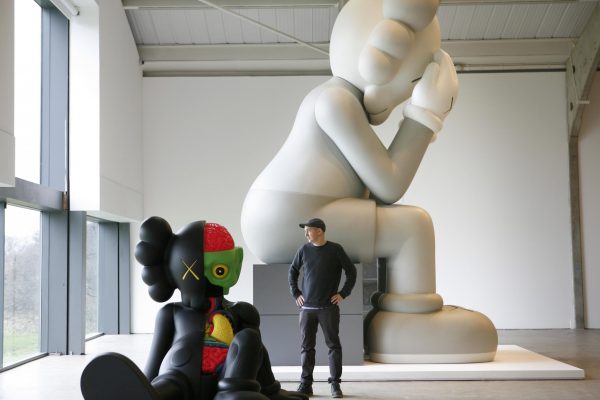
KAWS was a teenager growing up in Jersey City in the late 1980s and early 1990s, where he spent his high school years graffiti-bombing trains, walls, and billboards. He honed his street-art act in New York City, hanging out with the spray cans wielding skate kids in downtown Manhattan. He graduated to a more covert form of interventionist street art in the mid-1990s, when he began unlocking the glass panels encasing bus stop and phone booth ads. He stole the posters, added his own graphics to them in acrylic paint, and then surreptitiously put them back. These hits were so skillfully executed, brushstrokes are never apparent in a KAWS paintings that often no one could distinguish the artist’s work from the original advertisement.
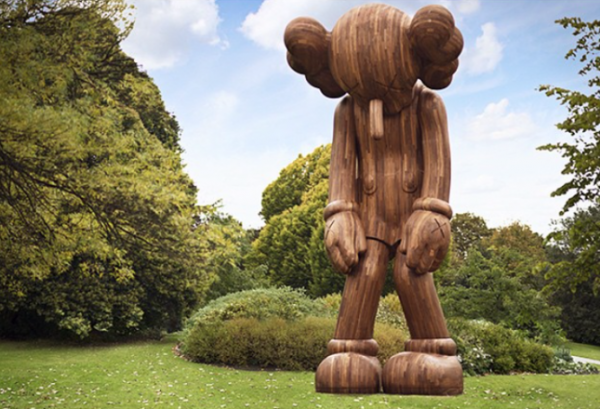
After graduating from New York’s School of Visual Arts in 1996, KAWS traveled to Japan, pursuing his street-art projects with Tokyo subculture heavyweights Hectic and Jun Takahashi of Undercover. In 1999, KAWS made his first toy with Japanese company Bounty Hunter,a vinyl figure of Mickey Mouse with x-ed out eyes (as if Mickey just drank from a bottle marked POISON). Nigo, the tastemaker behind A Bathing Ape, asked KAWS to collaborate on a clothing line in 2001 and began collecting his pop paintings of cartoon characters like the Simpsons, the Smurfs, and SpongeBob SquarePants. Read on to find out about his influence and inspiration.
TOBEY MAGUIRE: I’m interested in your backstory, how KAWS came to be. So let’s start there.
KAWS: I was born in Jersey City, and I guess that’s probably where it started. When I was young, I tried sports but never really got into them. I played ice hockey because there was a rink up the street from me, but once I grew out of my equipment, my parents were like, “Are you serious about this?” and I said, “Not really.?” I think I got into skating and graffiti mostly because they are both solo activities. You can take it where you want to without needing a team to play.
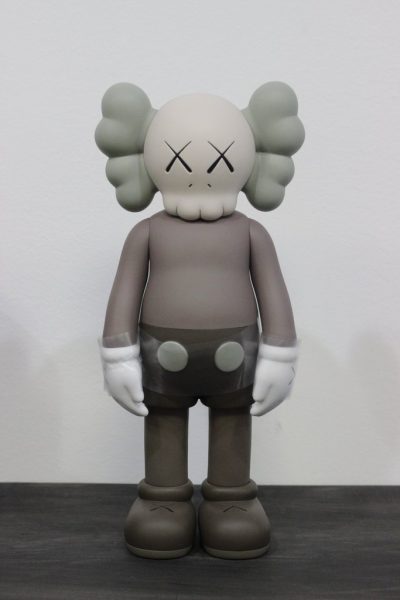
MAGUIRE: Did you have a drawing background? Did you take art classes as a kid?
KAWS: In elementary school I was a bad kid, not bad as in bad behavior but kind of illiterate bad. My fifth grade teacher told my mom, “Maybe he can pursue art”? But really, I had no background. Even in high school, art wasn’t something that occurred to me to pursue. It was just a hobby that I had a heavy leaning toward.
MAGUIRE: So it was more that you were just immersed as a teen in the culture of skating and that led you to art?
KAWS: Definitely. Jersey City is so close to Manhattan. You took the PATH train in for a dollar, so it would only cost $2 for a whole day of skating, from Brooklyn Banks to Tompkins Square Park. I would meet tons of kids from different boroughs, and that parlayed into graffiti. I got mixed into that.
MAGUIRE: What was your family like?
KAWS: My mom’s a housewife. My dad’s a stock-broker. He didn’t graduate from high school. He started by running coffee for the guys on Wall Street.
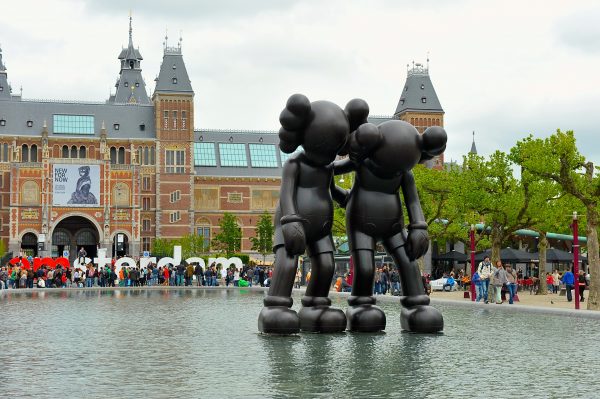
MAGUIRE: Where did the name KAWS come from?
KAWS: There’s no meaning to it. It’s just letters that I liked, K-A-W-S. I felt like they always work and function nicely with each other.
MAGUIRE: But let’s stop and think about that for a second. What is your cause? [KAWS] I mean, at that point in your life, were you thinking about becoming successful, making money, or just sharing your art? What were you doing it for? What was your approach?
KAWS: I didn’t know for a long time. The graf stuff was almost like a sport I fell into and was good at. I woke up wanting to do it and fell asleep thinking about it. When I was in school, my mind would be on painting. I guess that’s the only thing I’ve ever really been focused on. When I started painting on advertisements, it occurred to me that the ad really set the work in a specific time. You could look at a dozen walls and an untrained eye might not be able to distinguish the difference between the â??80s and â??90s. When you paint over ads, it clicksâ??especially with the phone booths I was doing. There were these Calvin Klein ads of Kate Moss or Christy Turlington. I think that’s when I realized it was more about communication.
MAGUIRE: How did you first get involved with making toys?
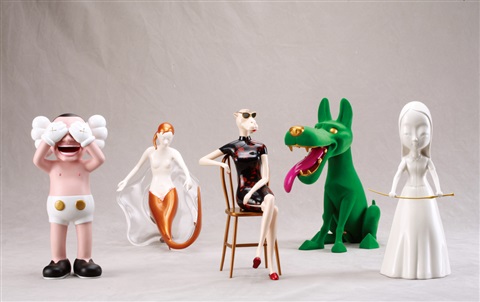
KAWS: I was always really into the pop artists and the editions they would make with Gemini G.E.L. I just didn’t think I’d meet anyone who would actually ask me to do a sculpture. But in 1997, I went to Tokyo and started developing a relationship with some guys who’s making stuff with different companies. The opportunity came up to make a toy. There was a company called Bounty Hunter that was making some of the first toys that were a little bit different. Before that, my idea of a toy was, like, Kenner or Hasbro. But they were making small runs of 500 toys. As soon as I saw them, I thought, These are like those Gemini editions. It’s just that people’s perception of a toy is different. I had to figure out a way of seeing my work in 3-D. My project opened up. I did rotation drawings, and they came back with a sculpture that I would adjust.
MAGUIRE: Do you see a toy and a sculpture as roughly the same thing?
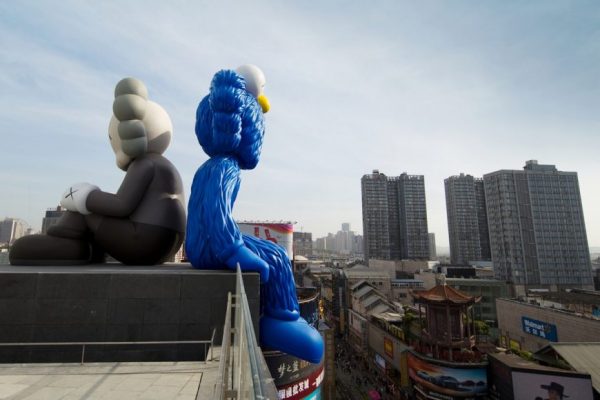
KAWS: The material and scale are different, that’s all. I’ve been doing bronze sculptures where I auto- body-paint them different colors. Those materials are traditional. They are within the history of fine art. But, in my mind, it’s the same dimensional process. I remember I took the toys to the New Museum to sell them on consignment. And Colette in Paris sold some for me. I took that money and produced my next toy.
MAGUIRE: You were giving yourself the freedom not to follow the traditional route to a fine-art career but instead chose to cut your own path. Seems bold.
KAWS: I guess my goal has been just to figure out how to get through life making stuff.
MAGUIRE: And eventually Pharrell started collecting your work.
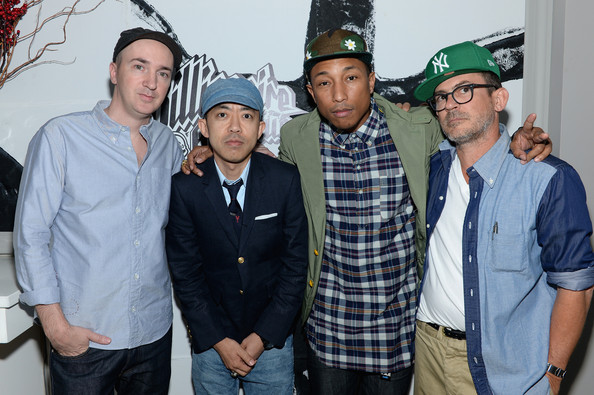
KAWS: Yes. That’s through Nigo. Nigo is one of my biggest supporters. The only paintings in his house in Tokyo are mine. Aside from my paintings, what he really collects is Bentleys. He has crazy cars. His house is out of control. Do you know that series of package paintings that I did? That was because I saw that these guys in Japan were collecting toys. I had friends that were spending $3,000 on a Star Wars prototype figure. They weren’t collecting art, they were collecting toys. So I did those package paintings where I mass-produced the packaging around the painting, but the painting itself was done individually. That was my way of bridging the gap between those two worlds. Because I realized that these guys are absolute connoisseurs of the stuff they collect. They can look at a toy and say, “Oh, this is a 1976. It came out in three versions.” It occurred to me that that kind of obsessive collecting isn’t any different than art.
MAGUIRE: You’ve had a lot of great support. How much of your success has been about sticking to your own vision and how much has it come from certain people saying, “Go ahead, take that step?”
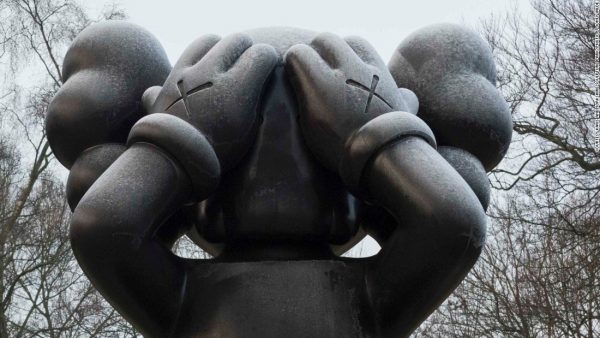
KAWS: I’ve been really lucky to be able to find people who could understand my interests and give it a chance. Years back, when I talked to some people about doing shows, they came in and saw the package paintings and my toys and said, “This is very commercial. I think they didn’t understand that it’s not like I make these toys for the money. The toys are actually part of the work. It’s what I want to do. No matter how things go in the gallery world, I’m still going to want to make product.
MAGUIRE: Is there an artist who particularly influenced you?
KAWS: I think the pop artists like Oldenburg and [Tom] Wesselmann. Then there were artists like Murakami, who really opened up a lot of doors on acceptance and crossover projects. That made what I was doing a bit easier to translate. And definitely Jeff Koons. I love his work. I appreciate his perfectionist mentality. It’s so over the top.
Extracted from the original article on interview magazine by Tobey Maguire. Photos belong to their respective owners courtesy of the internet.
